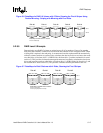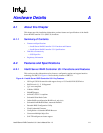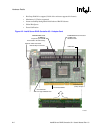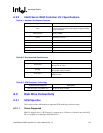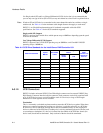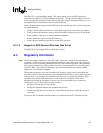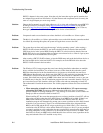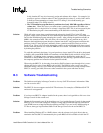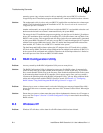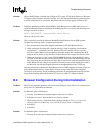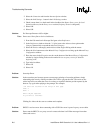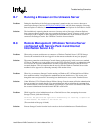
Intel® Server RAID Controller U3-1 User’s Manual Rev 1.0 B-1
Troubleshooting Scenarios B
B.1 Summary of Contents
• Hardware Troubleshooting
• Software Troubleshooting
• RAID Configuration Utility
• Windows NT
• Browser Configuration During Initial Installation
• Running a Browser on the Unixware Server
• Remote Management (Windows Terminal Server configured with Service Pack 4 and Internet
Information Server 4.0)
B.2 Hardware Troubleshooting
Problem: The system does not recognize the adapter card after it is inserted into the server.
Solution: If the system does not list the card as one of the PCI devices in the BIOS, then:
• Ensure the adapter card is inserted correctly into the PCI slot.
• Ensure 3.3 Volts are being supplied to the PCI slot.
• Try another PCI slot.
• Ensure the PCI slot is not specified for any special purpose other than standard PCI
configuration.
Problem: The boot device cannot be found.
Solution: Enter the system BIOS utility per manufacturer directions and configure it so that the RAID
volume is once again selected as the primary boot device (or first in the boot device list).
If the RAID card is physically moved from one PCI slot to another and the boot device is a RAID
volume controlled by the RAID card, some systems will automatically reconfigure some of the
system BIOS settings (boot device order). This issue is related to how the system BIOS operates
and may not occur with all systems.
Problem: If you have two Intel® Server RAID Controller U3-1 (SRCU31) adapters installed in the system,
there is no hyperlink in Storage Console to view the second card.
Using two SRCU31 controllers in one system is a supported configuration, however, there are
some caveats that must be understood before setting up two SRCU31 adapters in one system. Only
the advanced user should configure two SRCU31 controllers in one system. It is important to
understand how to use the following tools and software when working with or configuring two



